The Role of Vaccination and Face Mask Wearing on COVID-19 Infection and Hospitalization: A Cross-Sectional Study of the MENA Region
Abstract
:1. Introduction
2. Materials and Methods
2.1. Overview and Questionnaire Development
2.1.1. Conception
- Did you consistently wear a mask? (In public places, in the presence of others…etc.) (Yes/no);
- Have you respected social distancing? (Yes/no);
- Did you adhere to strict hygiene? (Yes/no);
- Did you avoid gatherings? (Yes/no);
- Have you been vaccinated? (Yes/no);
- Have you been infected with COVID-19? (Yes/no);
- Have you been treated? (Yes/no);
- Have you been hospitalized for COVID-19? (Yes/no);
- What is your age on the day of the survey?
2.1.2. Instrument
2.1.3. Ethics
2.2. The Statistical Model
2.3. AUC-ROC Curve
3. Results
3.1. Descriptive Statistics
- have you been exposed to COVID-19? (Confirmed by PCR or any test).
- have you been hospitalized as a result of COVID-19?
- Also, the explanatory variables with binary response are taken as follows:
- (to protect himself, the individual i wears the mask at all times), (the individual does not wear the mask all the time).
- (to protect himself, the individual () has received COVID-19 vaccination), (the individual () has not received COVID-19 vaccination).
3.2. Results of the Logistic Regression
4. Discussion
5. Conclusions
Author Contributions
Funding
Institutional Review Board Statement
Informed Consent Statement
Data Availability Statement
Acknowledgments
Conflicts of Interest
References
- World Health Organization. Novel Coronavirus (2019-nCoV) Situation Reports. Available online: https://www.who.int/fr/emergencies/diseases/novel-coronavirus-2019 (accessed on 2 March 2023).
- WHO Director-General’s Opening Remarks at the Media Briefing on COVID-19—11 March 2020. Available online: https://www.who.int/director-general/speeches/detail/who-director-general-s-opening-remarks-at-the-media-briefing-on-covid-19---11-march-2020 (accessed on 2 March 2023).
- Lauer, S.A.; Grantz, K.H.; Bi, Q.; Jones, F.K.; Zheng, Q.; Meredith, H.R.; Azman, A.S.; Reich, N.G.; Lessler, J. The Incubation Period of Coronavirus Disease 2019 (COVID-19) From Publicly Reported Confirmed Cases: Estimation and Application. Ann. Intern. Med. 2020, 172, 577–582. [Google Scholar] [CrossRef] [PubMed]
- Aouissi, H.A.; Belhaouchet, I. What about Rheumatic Diseases and COVID-19? New Microbes New Infect. 2021, 41, 100846. [Google Scholar] [CrossRef]
- Lippi, G.; Lavie, C.J.; Sanchis-Gomar, F. Cardiac Troponin I in Patients with Coronavirus Disease 2019 (COVID-19): Evidence from a Meta-Analysis. Prog. Cardiovasc. Dis. 2020, 63, 390–391. [Google Scholar] [CrossRef] [PubMed]
- Coronavirus Pandemic (COVID-19). Available online: https://ourworldindata.org/coronavirus (accessed on 2 March 2023).
- Capalbo, C.; Aceti, A.; Simmaco, M.; Bonfini, R.; Rocco, M.; Ricci, A.; Napoli, C.; Rocco, M.; Alfonsi, V.; Teggi, A.; et al. The Exponential Phase of the COVID-19 Pandemic in Central Italy: An Integrated Care Pathway. Int. J. Environ. Res. Public Health 2020, 17, 3792. [Google Scholar] [CrossRef] [PubMed]
- Lounis, M.; Rais, M.A.; Bencherit, D.; Aouissi, H.A.; Oudjedi, A.; Klugarová, J.; Pokorná, A.; Klugar, M.; Riad, A. Side Effects of COVID-19 Inactivated Virus vs. Adenoviral Vector Vaccines: Experience of Algerian Healthcare Workers. Front. Public Health 2022, 10, 896343. [Google Scholar] [CrossRef]
- Hamimes, A.; Benamirouche, R.; Chellai, F. Etude Comparative de la Situation Epidemiologique de COVID-19 en Algerie Par Les Modeles SIR de Propagation Entre Plusieurs PAYS. RSSI 2021, 8, 23–33. [Google Scholar]
- Statsenko, Y.; Habuza, T.; Talako, T.; Kurbatova, T.; Simiyu, G.L.; Smetanina, D.; Sido, J.; Qandil, D.S.; Meribout, S.; Gelovani, J.G.; et al. Reliability of Machine Learning in Eliminating Data Redundancy of Radiomics and Reflecting Pathophysiology in COVID-19 Pneumonia: Impact of CT Reconstruction Kernels on Accuracy. IEEE Access 2022, 10, 120901–120921. [Google Scholar] [CrossRef]
- Boudrioua, M.S.; Boudrioua, A. Predicting the COVID-19 Epidemic in Algeria Using the SIR Model. medRxiv 2021. [Google Scholar] [CrossRef]
- Open Resource of Clinical Data from Patients with Pneumonia for the Prediction of COVID-19 Outcomes via Deep Learning|Nature Biomedical Engineering. Available online: https://www.nature.com/articles/s41551-020-00633-5 (accessed on 2 March 2023).
- Flesia, L.; Monaro, M.; Mazza, C.; Fietta, V.; Colicino, E.; Segatto, B.; Roma, P. Predicting Perceived Stress Related to the COVID-19 Outbreak through Stable Psychological Traits and Machine Learning Models. J. Clin. Med. 2020, 9, 3350. [Google Scholar] [CrossRef]
- Li, S.; Wang, Y.; Xue, J.; Zhao, N.; Zhu, T. The Impact of COVID-19 Epidemic Declaration on Psychological Consequences: A Study on Active Weibo Users. Int. J. Environ. Res. Public Health 2020, 17, 2032. [Google Scholar] [CrossRef]
- Mir, H.H.; Parveen, S.; Mullick, N.H.; Nabi, S. Using Structural Equation Modeling to Predict Indian People’s Attitudes and Intentions towards COVID-19 Vaccination. Diabetes Metab. Syndr. Clin. Res. Rev. 2021, 15, 1017–1022. [Google Scholar] [CrossRef] [PubMed]
- Alfawaz, H.; Yakout, S.M.; Wani, K.; Aljumah, G.A.; Ansari, M.G.A.; Khattak, M.N.K.; Hussain, S.D.; Al-Daghri, N.M. Dietary Intake and Mental Health among Saudi Adults during COVID-19 Lockdown. Int. J. Environ. Res. Public Health 2021, 18, 1653. [Google Scholar] [CrossRef] [PubMed]
- Ting, D.S.J.; Krause, S.; Said, D.G.; Dua, H.S. Psychosocial Impact of COVID-19 Pandemic Lockdown on People Living with Eye Diseases in the UK. Eye 2021, 35, 2064–2066. [Google Scholar] [CrossRef] [PubMed]
- Fu, W.; Yan, S.; Zong, Q.; Anderson-Luxford, D.; Song, X.; Lv, Z.; Lv, C. Mental Health of College Students during the COVID-19 Epidemic in China. J. Affect. Disord. 2021, 280, 7–10. [Google Scholar] [CrossRef] [PubMed]
- Liu, Z.; Liu, R.; Zhang, Y.; Zhang, R.; Liang, L.; Wang, Y.; Wei, Y.; Zhu, R.; Wang, F. Latent Class Analysis of Depression and Anxiety among Medical Students during COVID-19 Epidemic. BMC Psychiatry 2021, 21, 498. [Google Scholar] [CrossRef]
- Pandey, A.K.; Singh, G.N.; Sayed-Ahmed, N.; Abu-Zinadah, H. Improved Estimators for Mean Estimation in Presence of Missing Information. Alex. Eng. J. 2021, 60, 5977–5990. [Google Scholar] [CrossRef]
- Pandey, A.K.; Usman, M.; Singh, G.N. Optimality of Ratio and Regression Type Estimators Using Dual of Auxiliary Variable under Non Response. Alex. Eng. J. 2021, 60, 4461–4471. [Google Scholar] [CrossRef]
- Zuo, L.; Zhang, H.; Wang, H.; Sun, L. Optimal Subsample Selection for Massive Logistic Regression with Distributed Data. Comput. Stat. 2021, 36, 2535–2562. [Google Scholar] [CrossRef]
- Aouissi, H.A.; Hamimes, A.; Ababsa, M.; Bianco, L.; Napoli, C.; Kebaili, F.K.; Krauklis, A.E.; Bouzekri, H.; Dhama, K. Bayesian Modeling of COVID-19 to Classify the Infection and Death Rates in a Specific Duration: The Case of Algerian Provinces. Int. J. Environ. Res. Public Health 2022, 19, 9586. [Google Scholar] [CrossRef]
- Bhandari, S.; Heintz, K.E.; Aggarwal, K.; Marnoch, L.; Day, C.K.; Sydnor, J.; Burke-Spolaor, S.; Law, C.J.; Xavier Prochaska, J.; Tejos, N.; et al. Characterizing the Fast Radio Burst Host Galaxy Population and Its Connection to Transients in the Local and Extragalactic Universe. Astron. J. 2022, 163, 69. [Google Scholar] [CrossRef]
- Medina-Mendieta, J.F.; Cortés-Cortés, M.; Cortés-Iglesias, M. COVID-19 Forecasts for Cuba Using Logistic Regression and Gompertz Curves. MEDICC Rev. 2020, 22, 32–39. [Google Scholar] [PubMed]
- Josephus, B.O.; Nawir, A.H.; Wijaya, E.; Moniaga, J.V.; Ohyver, M. Predict Mortality in Patients Infected with COVID-19 Virus Based on Observed Characteristics of the Patient Using Logistic Regression. Procedia Comput. Sci. 2021, 179, 871–877. [Google Scholar] [CrossRef]
- Aouissi, H.A.; Kechebar, M.S.A.; Ababsa, M.; Roufayel, R.; Neji, B.; Petrisor, A.-I.; Hamimes, A.; Epelboin, L.; Ohmagari, N. The Importance of Behavioral and Native Factors on COVID-19 Infection and Severity: Insights from a Preliminary Cross-Sectional Study. Healthcare 2022, 10, 1341. [Google Scholar] [CrossRef] [PubMed]
- Leveau, C.M.; Aouissi, H.A.; Kebaili, F.K. Spatial Diffusion of COVID-19 in Algeria during the Third Wave. GeoJournal 2022, 88, 1175–1180. [Google Scholar] [CrossRef] [PubMed]
- Lounis, M.; Aouissi, H.A.; Abdelhadi, S.; Rais, M.A.; Belkessa, S.; Bencherit, D. Short-Term Adverse Effects Following Booster Dose of Inactivated-Virus vs. Adenoviral-Vector COVID-19 Vaccines in Algeria: A Cross-Sectional Study of the General Population. Vaccines 2022, 10, 1781. [Google Scholar] [CrossRef]
- Hamimes, A.; Aouissi, H.A.; Ababsa, M.; Lounis, M.; Jayarajah, U.; Napoli, C.; Kasemy, Z.A. The Effect of Preventive Measures and Vaccination against SARS-CoV-2 on the Infection Risk, Treatment, and Hospitalization: A Cross-Sectional Study of Algeria. Viruses 2022, 14, 2771. [Google Scholar] [CrossRef]
- von Elm, E.; Altman, D.G.; Egger, M.; Pocock, S.J.; Gøtzsche, P.C.; Vandenbroucke, J.P. Strengthening the Reporting of Observational Studies in Epidemiology (STROBE) Statement: Guidelines for Reporting Observational Studies. BMJ 2007, 335, 806. [Google Scholar] [CrossRef]
- Aouissi, H.A. Algeria’s Preparedness for Omicron Variant and for the Fourth Wave of COVID-19. Glob. Health Med. 2021, 3, 413–414. [Google Scholar] [CrossRef]
- WMA. The World Medical Association Declaration of Helsinki—Ethical Principles for Medical Research Involving Human Subjects. JAMA 2013, 310, 2191–2194. [Google Scholar] [CrossRef]
- Hilbe, J.M. Practical Guide to Logistic Regression; Chapman and Hall/CRC: New York, NY, USA, 2016; ISBN 978-0-429-17446-9. [Google Scholar]
- Uusküla, A.; Jürgenson, T.; Pisarev, H.; Kolde, R.; Meister, T.; Tisler, A.; Suija, K.; Kalda, R.; Piirsoo, M.; Fischer, K. Long-Term Mortality Following SARS-CoV-2 Infection: A National Cohort Study from Estonia. Lancet Reg. Health Eur. 2022, 18, 100394. [Google Scholar] [CrossRef]
- Azlan, A.A.; Hamzah, M.R.; Sern, T.J.; Ayub, S.H.; Mohamad, E. Public Knowledge, Attitudes and Practices towards COVID-19: A Cross-Sectional Study in Malaysia. PLoS ONE 2020, 15, e0233668. [Google Scholar] [CrossRef] [PubMed]
- Galvin, C.J.; Li, Y.-C.; Malwade, S.; Syed-Abdul, S. COVID-19 Preventive Measures Showing an Unintended Decline in Infectious Diseases in Taiwan. Int. J. Infect. Dis. 2020, 98, 18–20. [Google Scholar] [CrossRef] [PubMed]
- Montagna, M.T.; De Giglio, O.; Cristina, M.L.; Napoli, C.; Pacifico, C.; Agodi, A.; Baldovin, T.; Casini, B.; Coniglio, M.A.; D’Errico, M.M.; et al. Evaluation of Legionella Air Contamination in Healthcare Facilities by Different Sampling Methods: An Italian Multicenter Study. Int J Environ Res Public Health 2017, 14, 670. [Google Scholar] [CrossRef] [PubMed]
- Beca-Martínez, M.T.; Romay-Barja, M.; Falcón-Romero, M.; Rodríguez-Blázquez, C.; Benito-Llanes, A.; Forjaz, M.J. Compliance with the Main Preventive Measures of COVID-19 in Spain: The Role of Knowledge, Attitudes, Practices, and Risk Perception. Transbound. Emerg. Dis. 2022, 68, e871–e882. [Google Scholar] [CrossRef]
- Doroshenko, A. The Combined Effect of Vaccination and Nonpharmaceutical Public Health Interventions—Ending the COVID-19 Pandemic. JAMA Network Open 2021, 4, e2111675. [Google Scholar] [CrossRef] [PubMed]
- Inc, G. Americans’ Face Mask Usage Varies Greatly by Demographics. Available online: https://news.gallup.com/poll/315590/americans-face-mask-usage-varies-greatly-demographics.aspx (accessed on 2 March 2023).
- Felter, C.; Bussemaker, N. Which Countries Are Requiring Face Masks? Council on Foreign Relations: New York, NY, USA, 2020. [Google Scholar]
- Sugimura, M.; Chimed-Ochir, O.; Yumiya, Y.; Ohge, H.; Shime, N.; Sakaguchi, T.; Tanaka, J.; Takafuta, T.; Mimori, M.; Kuwabara, M.; et al. The Association between Wearing a Mask and COVID-19. Int. J. Environ. Res. Public Health 2021, 18, 9131. [Google Scholar] [CrossRef]
- Moussaoui, A.; Zerga, E.H.; Moussaoui, A.; Zerga, E.H. Transmission Dynamics of COVID-19 in Algeria: The Impact of Physical Distancing and Face Masks. AIMSPH 2020, 7, 816–827. [Google Scholar] [CrossRef]
- Lauring, A.S.; Tenforde, M.W.; Chappell, J.D.; Gaglani, M.; Ginde, A.A.; McNeal, T.; Ghamande, S.; Douin, D.J.; Talbot, H.K.; Casey, J.D.; et al. Clinical Severity of, and Effectiveness of MRNA Vaccines against, COVID-19 from Omicron, Delta, and Alpha SARS-CoV-2 Variants in the United States: Prospective Observational Study. BMJ 2022, 376, e069761. [Google Scholar] [CrossRef]
- Marrone, G.; Nicolay, N.; Bundle, N.; Karki, T.; Spiteri, G.; Suija, H.; Kärblane, K.-G.; Mossong, J.; Vergison, A.; Avdicova, M.; et al. Risk Reduction of Severe Outcomes in Vaccinated COVID-19 Cases: An Analysis of Surveillance Data from Estonia, Ireland, Luxembourg and Slovakia, January to November 2021. Eurosurveillance 2022, 27, 2200060. [Google Scholar] [CrossRef]
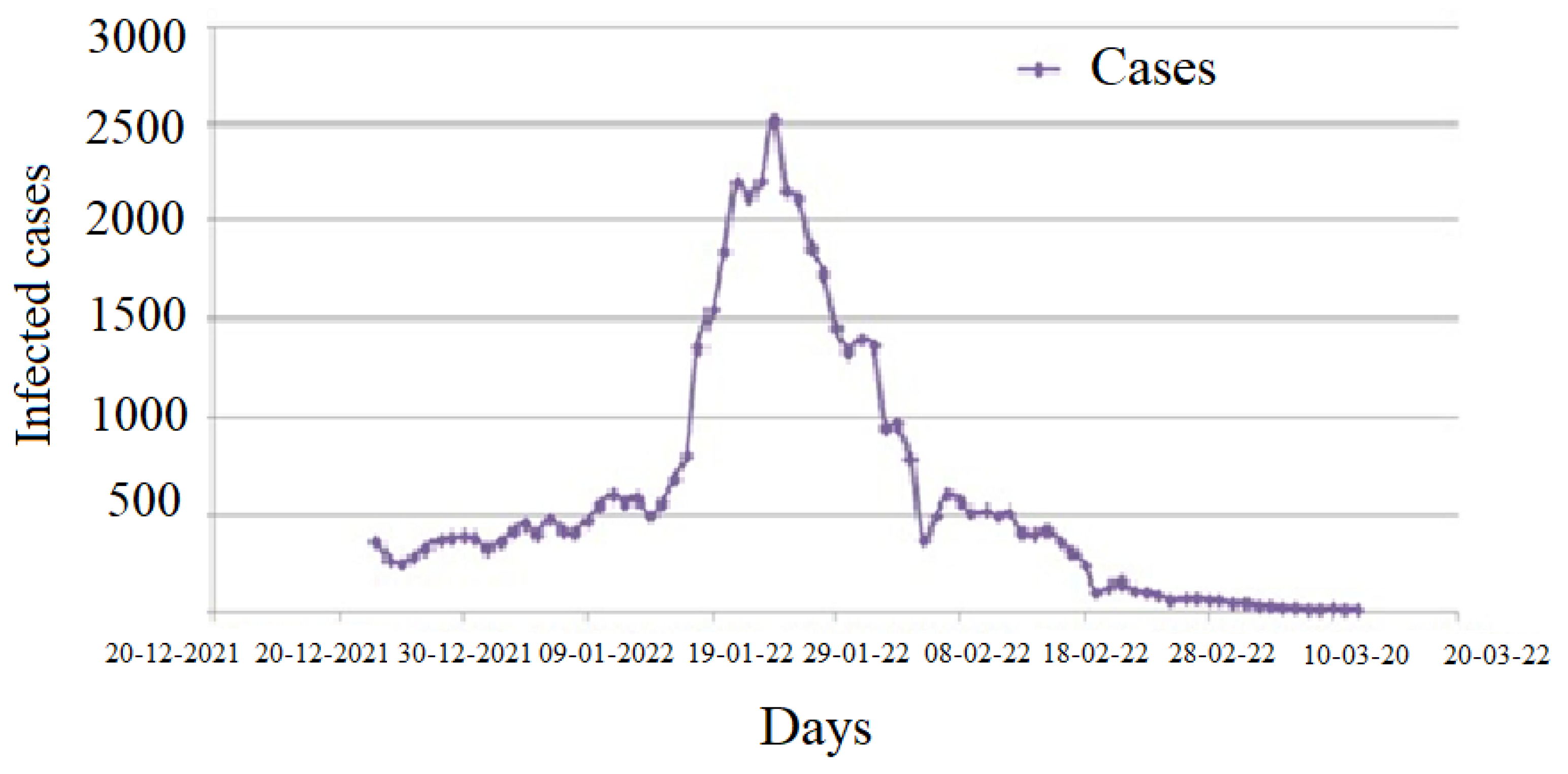
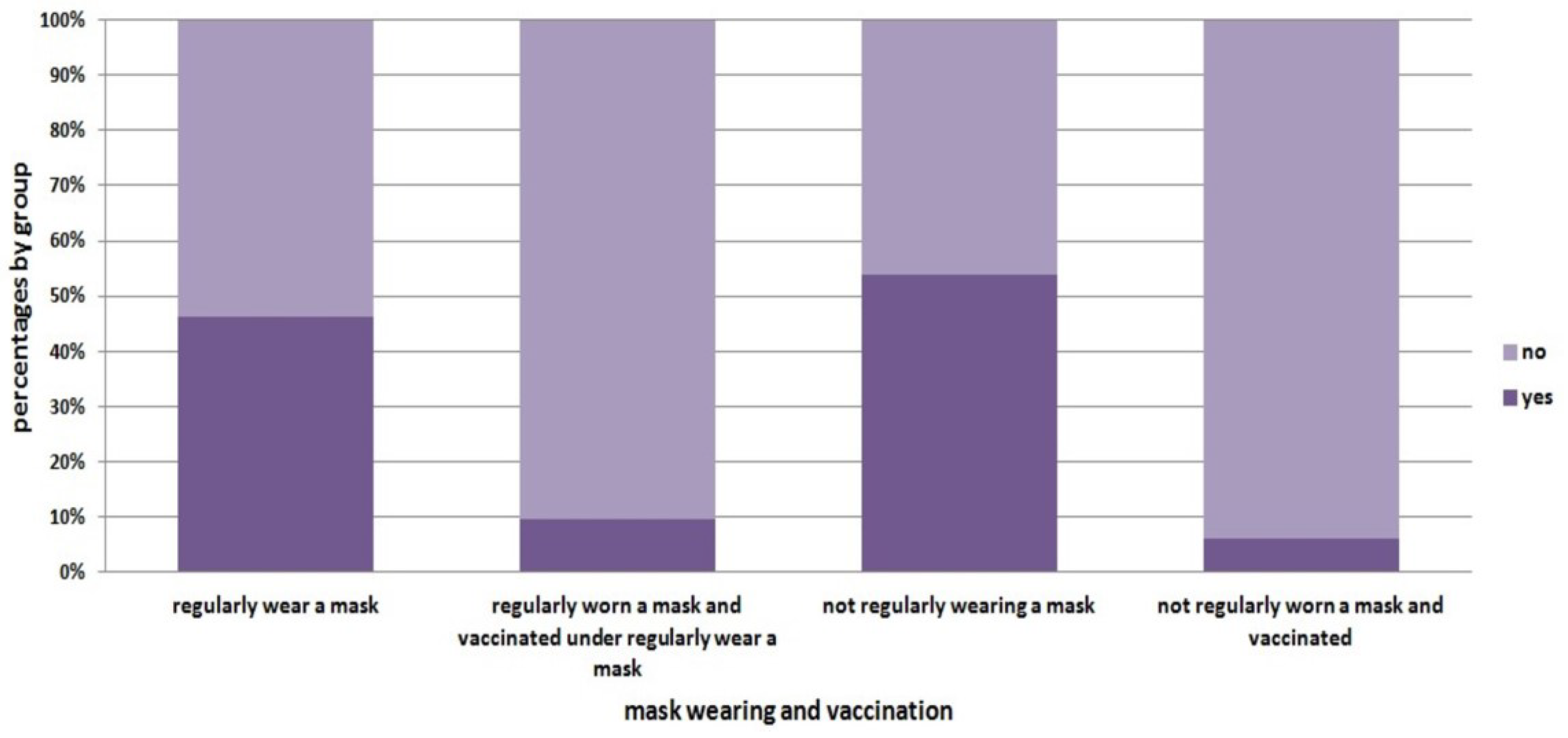
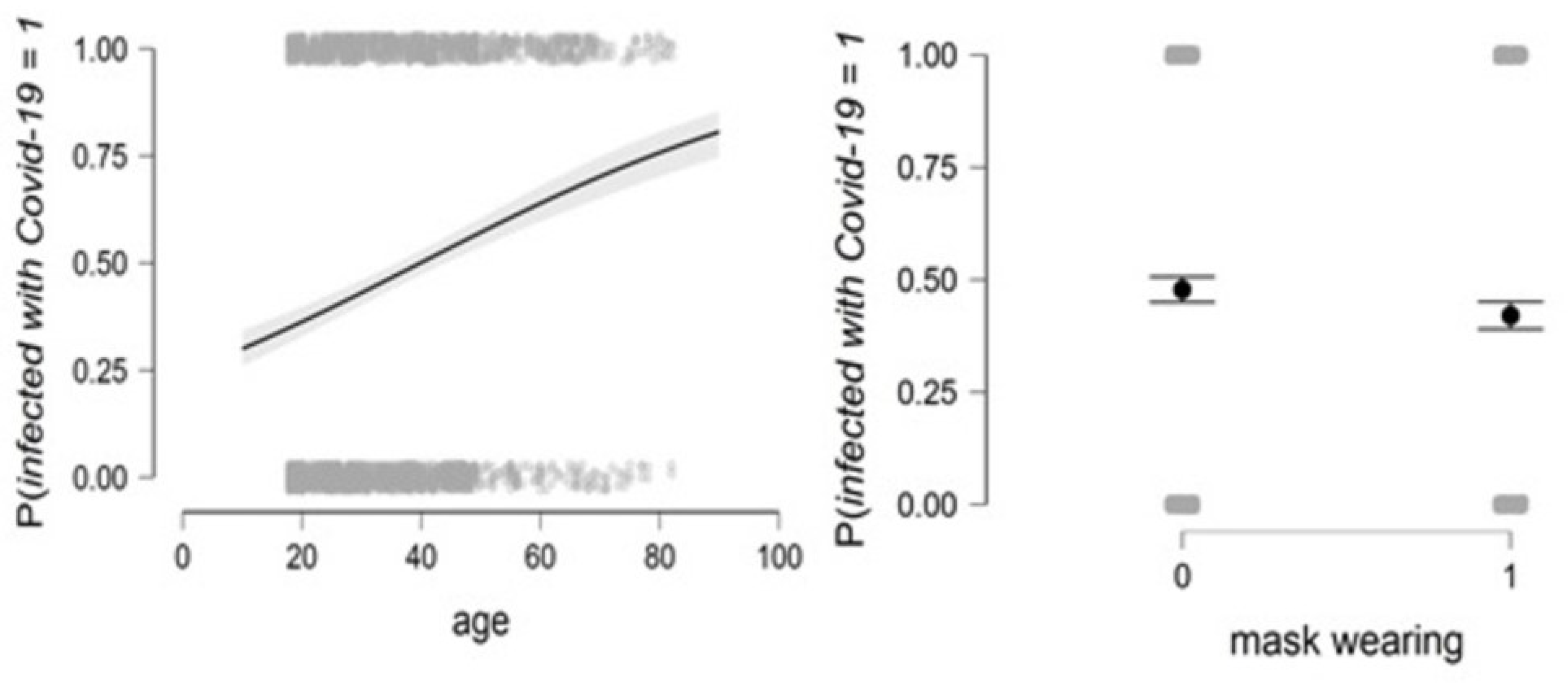
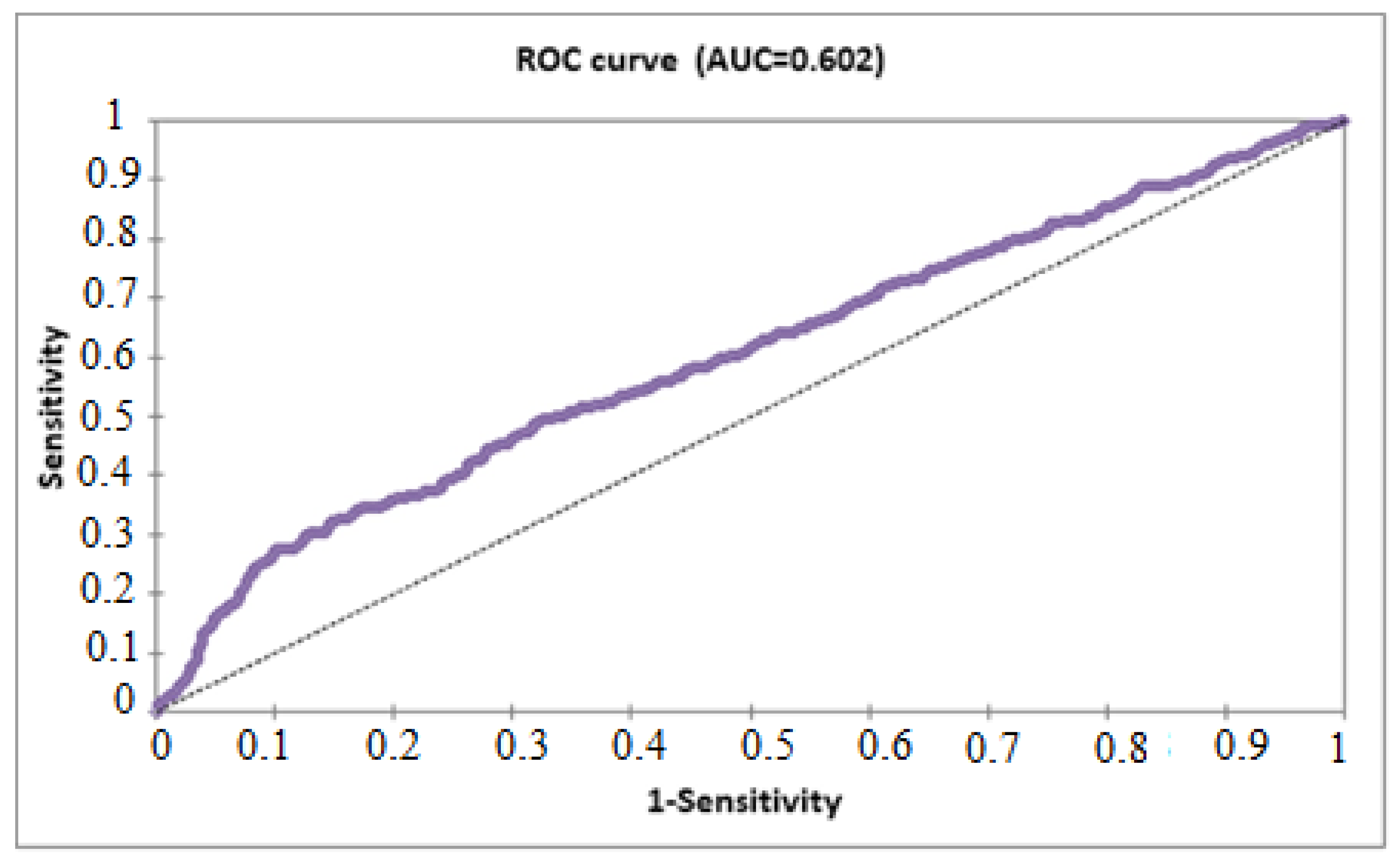
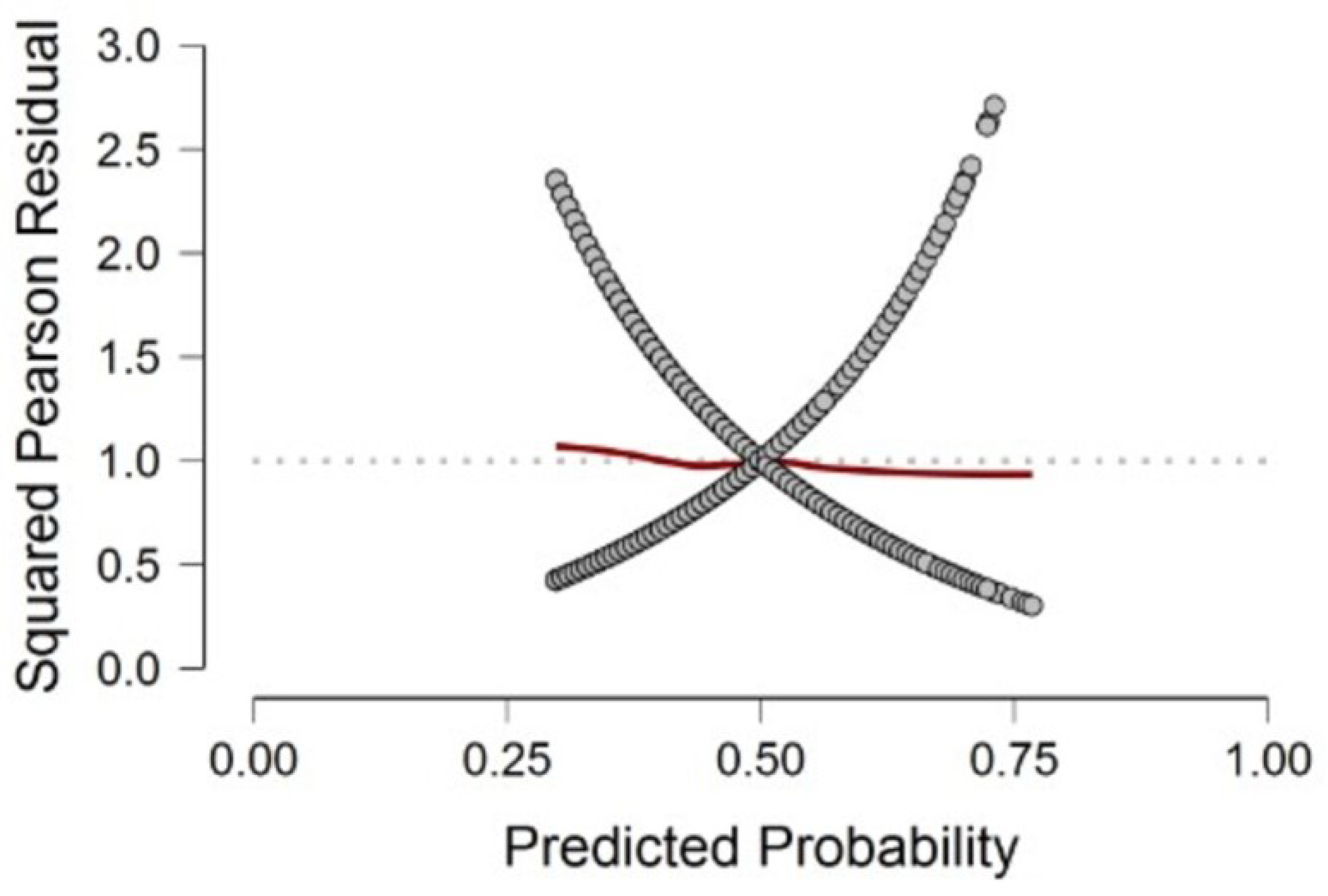
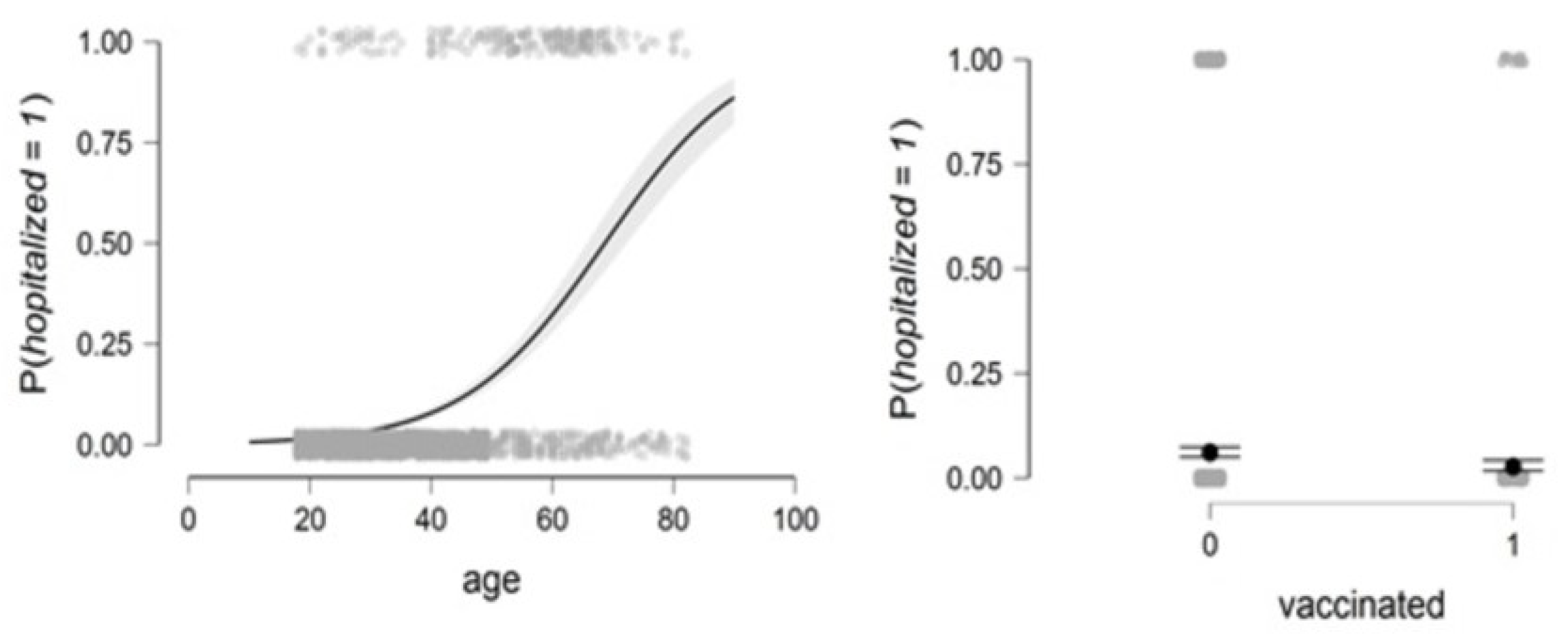
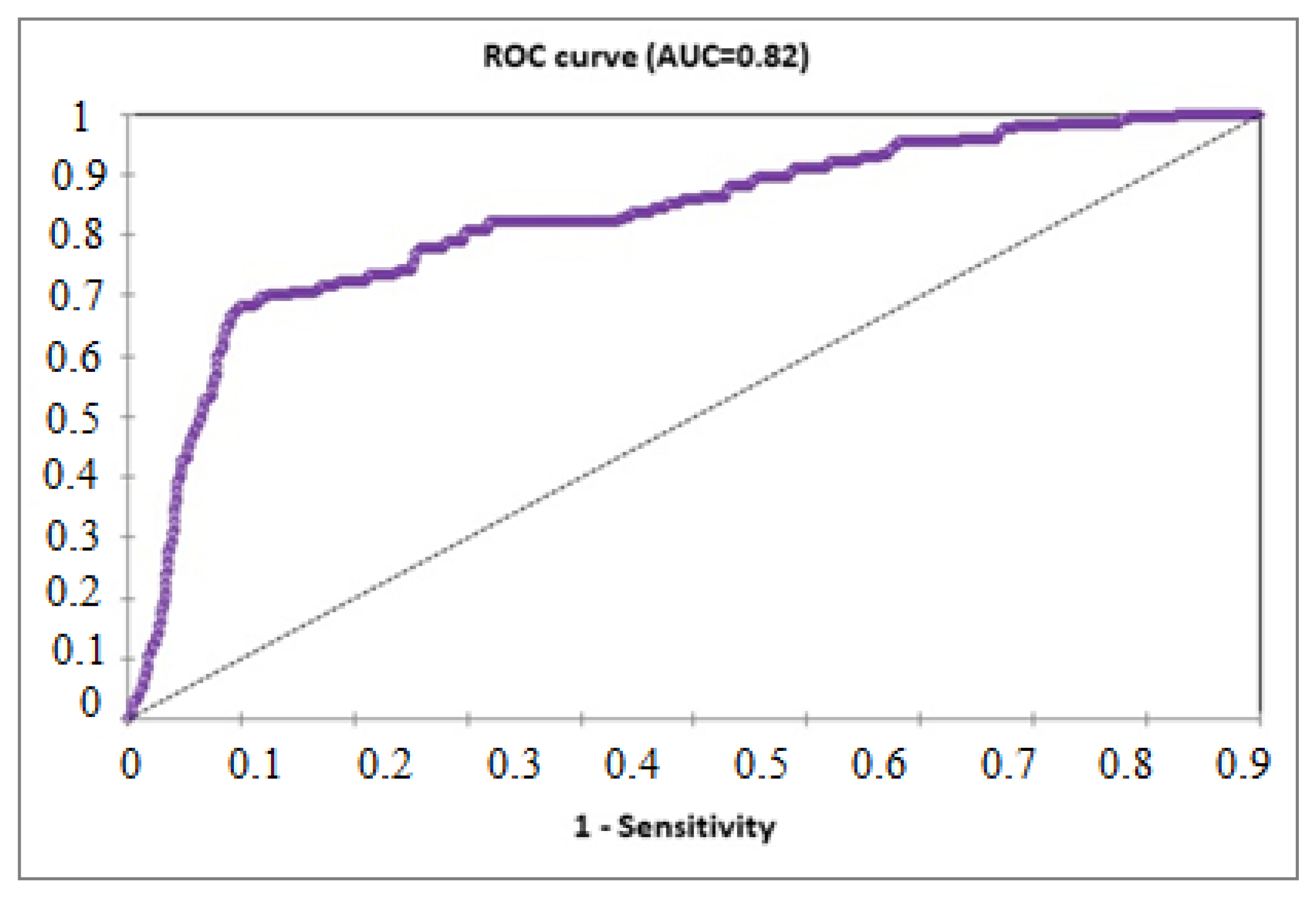

| Variable | Response | N (%) |
|---|---|---|
| Did you frequently wear a facemask? | No | 1236 (54%) |
| Yes | 1058 (46%) | |
| Have you been immunized with a vaccine? (at least one dose) | No | 1933 (84%) |
| Yes | 361 (16%) | |
| Have you been exposed to COVID-19? (Confirmed) | No | 1256 (55%) |
| Yes | 1038 (45%) | |
| Have you been hospitalized as a result of COVID-19? | No | 2080 (91%) |
| Yes | 214 (9%) |
| Source | Value | SE (Standard Error) | p-Value | OR | Lower CI (95%) | Upper CI (95%) |
|---|---|---|---|---|---|---|
| −1.131 | 0.128 | <0.0001 | ||||
| 0.028 | 0.003 | <0.0001 | 1.029 | 1.023 | 1.035 | |
| −0.235 | 0.086 | 0.006 | 0.791 | 0.668 | 0.936 |
| Statistic | Observations | DDL | −2 Log (Likelihood) | R2 (McFadden) | AIC |
|---|---|---|---|---|---|
| Independent () | 2294 | 2293 | 3159 | 0.000 | 3161 |
| Complete () | 2294 | 2291 | 3064 | 0.030 | 3070 |
| Source | Value | SE | p-Value | OR | OR Lower CI. (95%) | OR Upper CI. (95%) | |
|---|---|---|---|---|---|---|---|
| −5.892 | 0.275 | 459.256 | <0.0001 | ||||
| 0.086 | 0.005 | 248.104 | <0.0001 | 1.090 | 1.078 | 1.101 | |
| −0.845 | 0.232 | 13.305 | 0 | 0.429 | 0.273 | 0.676 |
| Statistic | Observations | DDL | −2 Log (Likelihood) | R2 (McFadden) | AIC |
|---|---|---|---|---|---|
| Independent () | 2294 | 2293 | 1422 | 0 | 2294 |
| Complete () | 2294 | 2291 | 1118 | 0.214 | 2294 |
Disclaimer/Publisher’s Note: The statements, opinions and data contained in all publications are solely those of the individual author(s) and contributor(s) and not of MDPI and/or the editor(s). MDPI and/or the editor(s) disclaim responsibility for any injury to people or property resulting from any ideas, methods, instructions or products referred to in the content. |
© 2023 by the authors. Licensee MDPI, Basel, Switzerland. This article is an open access article distributed under the terms and conditions of the Creative Commons Attribution (CC BY) license (https://creativecommons.org/licenses/by/4.0/).
Share and Cite
Hamimes, A.; Lounis, M.; Aouissi, H.A.; Roufayel, R.; Lakehal, A.; Bouzekri, H.; Byeon, H.; Ababsa, M.; Napoli, C. The Role of Vaccination and Face Mask Wearing on COVID-19 Infection and Hospitalization: A Cross-Sectional Study of the MENA Region. Healthcare 2023, 11, 1257. https://doi.org/10.3390/healthcare11091257
Hamimes A, Lounis M, Aouissi HA, Roufayel R, Lakehal A, Bouzekri H, Byeon H, Ababsa M, Napoli C. The Role of Vaccination and Face Mask Wearing on COVID-19 Infection and Hospitalization: A Cross-Sectional Study of the MENA Region. Healthcare. 2023; 11(9):1257. https://doi.org/10.3390/healthcare11091257
Chicago/Turabian StyleHamimes, Ahmed, Mohamed Lounis, Hani Amir Aouissi, Rabih Roufayel, Abdelhak Lakehal, Hafid Bouzekri, Haewon Byeon, Mostefa Ababsa, and Christian Napoli. 2023. "The Role of Vaccination and Face Mask Wearing on COVID-19 Infection and Hospitalization: A Cross-Sectional Study of the MENA Region" Healthcare 11, no. 9: 1257. https://doi.org/10.3390/healthcare11091257










